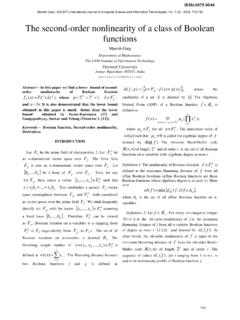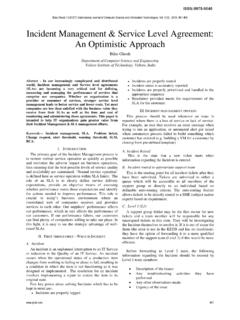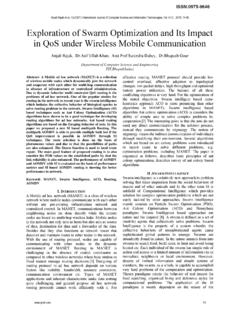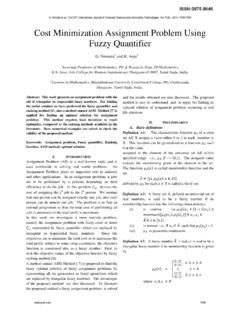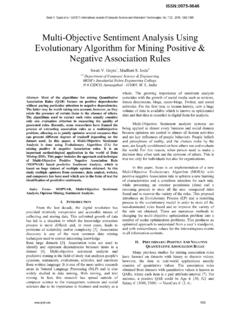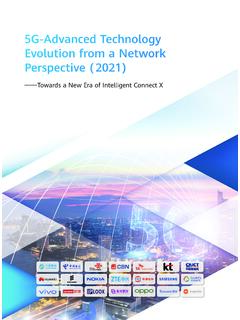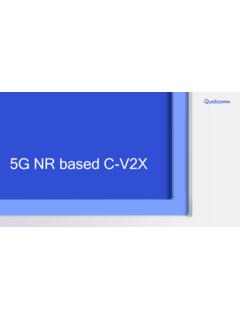Transcription of 123. Evolution of Mobile Wireless Technology from 0G to 5G
1 Evolution of Mobile Wireless Technology from 0G to 5G. Mohammad Meraj ud in Mir , Dr. Sumit Kumar Abstract -The ability to communicate with people on move has evolved remarkably, since Guglielmo Marconi, first demonstrated radio ability to provide continuous contact with ships. The Mobile Wireless evolved in a very short span of time. In this paper I will through light on Evolution of Mobile Wireless Communication Networks along with their significance and advantage of one over the other. In few past decades , the Mobile Wireless Evolution progressed from Zero Generation (0G) to First Generation (1G), Second Generation (2G), Third Generation (3G), and now Fourth Generation (4G) systems are being deployed with the aim Quality of Service (QoS), efficiency and performance.
2 Mobile Wireless Technology have reached to 4G or 5G of Technology . 1G Technology made large scale Mobile Wireless communication possible. Digital communication has replaced analog Technology in 2G which significantly improved Wireless communication. Voice communication was main focus in 3G Technology , and converged networks for both voice and data communication was main focus in 3G Technology , and converged networks for both voice and data communication is emerging. Currently 5G term is not officially used. In 5G researches are being made on development of WWWW, Dynamic Adhoc Wireless networks(DAWN) etc.
3 Key words:- Mobile Wireless Communication, Networks, 0G, 1G, 2G, 3G, 4G, 5G, Mobile Broadband, Wi-Fi, GSM. INTRODUCTION Mobile Wireless industry has started its Technology creation, revolution and Evolution since early 1970. From Mid 1990 s the cellular communication industry has witnessed explosive growth. Wireless communication networks have become much more pervasive than anyone could have imagined when the cellular concept was first deployed in 1960 s and 1970 s. Mobile cellular subscribers are increasing 40% per year, and by the end of 2010 there will be 4 times more Mobile cellular subscription than fixed telephone lines.
4 The rapid world wide growth in cellular telephone subscribers has demonstrated conclusively that Wireless communications is a robust, viable voice and data transport mechanism. The wide spread success of cellular has led to the development of newer Wireless system and standards for many other types of telecommunication traffic besides Mobile voice telephone calls. Why we use Wireless communication Wireless Technology are differentiated on the basis of their range. Some offer connectivity within few feet s viz. Bluetooth and other cover medium sized office space. The Mobile phone covers whole continents.
5 Wireless Technology offer e-commerce more flexible and in-expensive ways to send and receive data. The four key benefits of Wireless Technology are as under:- efficiency:- High technologycommunication systems lead to faster transfer ofinformation within business and between out of touch:- No need to carry cables oradapters in order to access office flexibility for users:- Wireless workers inthe office can be networked without sitting atdedicated PC Cost:- Wireless networks are mostlycheaper to install and maintain than wired :- After going through the era of 1G & 2G from the early 1900s to 2000, 3G first came into the scene in the year 2001.
6 The first pre-commercial trial network with 3G was launched by NTT DoCoMo in Japan in the Tokyo region in May 2001. NTT DoCoMo launched the first commercial 3G network on October 1, 2001, using the WCDMA Technology . In 2002 the first 3G networks on the rival CDMA2000 1xEV-DO Technology were launched by SK Telecom and KTF in South Korea, and Monet in the USA. Monet has since gone bankrupt. By the end of 2002, the second WCDMA network was launched in Japan by Vodafone KK (now Softbank). In March the first European launches of 3G were in Italy and the UK by the Three/Hutchison group, on WCDMA.
7 2003 saw a further 8 commercial launches of 3G, six more on WCDMA and two more on the EV-DO standard. By the end of 2007 there were 295 Million subscribers on 3G networks worldwide, which reflected 9% of the total worldwide subscriber base. About two thirds of these are on the WCDMA standard and one third on the EV-DO standard. The 3G telecoms services generated over 120 Billion dollars of revenues during 2007 and at many markets the majority of new phones activated were 3G phones. In Japan and South Korea the market no longer supplies phones of the second generation. Earlier in the decade there were doubts about whether 3G might happen, and also whether 3G might become a commercial success.
8 By the end of 2007 it had become clear that 3G was a reality and was clearly on the path to become a profitable venture. On the other hand, 4G has a very short history thus far. It started from the year 2008 and has not been implemented fully yet. Sprint made history in September 2008 when it became the first major US carrier to launch a 4G network in Baltimore. This week it expanded its coverage to three more cities and announced plans to launch 17 additional new markets in 2009. Evolution of Mobile cellular Networks Cellular Mobile communication has generations as shown in the figure.
9 The brief description of every generation is given as under:- Mohammad Meraj ud in Mir et al, / (IJCSIT) International Journal of Computer Science and Information Technologies, Vol. 6 (3) , 2015, Figure:- Block diagram of Evolution of Wireless network. 0G Wireless telephone started with 0G, which became available after World War-II. In those pre-cell days, Mobile operator sets up the calls and there were only a handful of channels available. These mobiles does not support the handover feature Change of channel frequency. 0G refers to pre cellular Mobile telephony Technology in 1970 s., such as Radio telephones that some had in cars before the advent of cell phones.
10 Mobile radio telephonic system produced modern cellular Mobile -telephony Technology . Since they were predecessors of first generation of cellular telephones, these systems, are called 0G ( Zero Generation) Systems. Technologies used in 0G systems included PTT (Push to Talk), MTS ( Mobile Telephone System) , IMTS (Improved Mobile Telephone Service),AMTS (Advanced Mobile Telephone System), OLT (Norwegian for Offentlig Landmobil Telefoni ,Public Land Mobile Telephony) and MTD (Swedish abbreviation for Mobile Telephony system D). The primary users were loggers, construction foremen, realtors and celebrities.
